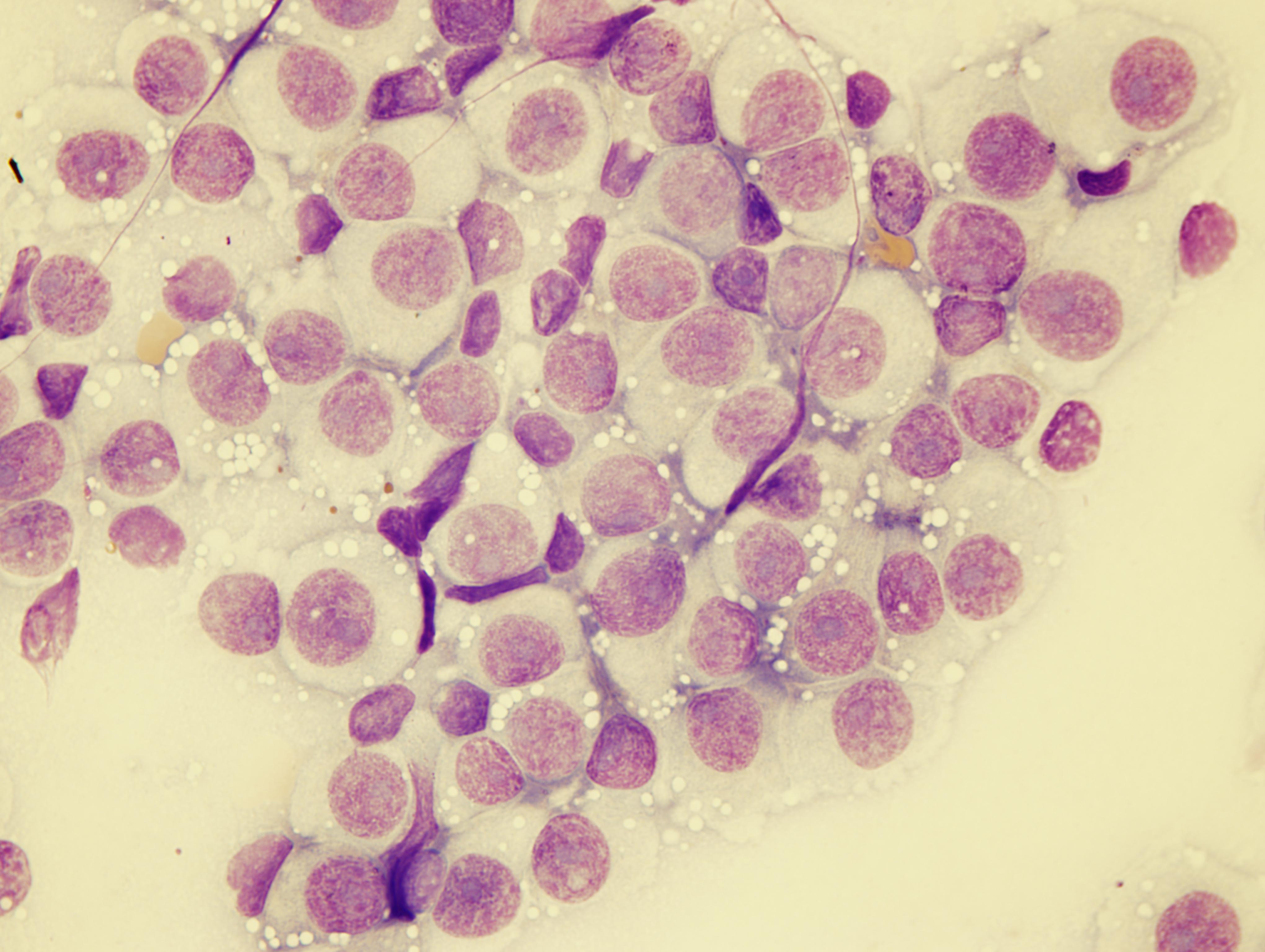| Noninfectious
Infertility
 p 257-270 p 257-270

- Breeding management is usually the number one
problem associated with infertility.
- Breeders will 'count days' and breed on days 11 and 13 when the
bitch is not really in heat and wonder why breeding did not occur.
See estrous cycle graph.
-
Breeding will be left up to the male, so estrus detection and/or
breeding may not occur.
- It is essential that proper breeding
management be used and that the breeding be timed properly and a
fertile male used. Always manage one breeding before investigating
any other infertility problems with too much vigor.
- Male infertility should be investigated. Has the
male sired litters recently? A Breeding Soundness Examination of
the male will ensure a relatively fertile male.
Functional breeding problems
of the Vagina
Vaginal strictures
- Vaginal Strictures are a tight ring at vaginal-vestibular
junction. They cause pain on intromission, so the bitch won't let
the male breed. The client may present the bitch as 'not standing'
in heat.
- Diagnosis is by either digital
palpation or
vaginoscopy. On insertion you cannot get in the vagina or the
bitch shows pain on insertion.
- You can treat the condition using artificial
insemination. A stricture may predispose to dystocia, but usually
not.
Vaginal hyperplasia or hypertrophy or edema
 233 233
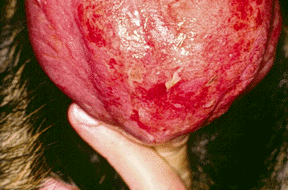
- Vaginal hyperplasia (currently called vaginal
edema...Root likes to call it vaginal prolapse!) usually occurs in younger,
large breed dogs at estrus. It results from excess reaction to normal
estrogen concentrations. It is actually edema of the tissue.
- You see a large red mass protruding from vulva.
If the condition is chronic, the mass may be dried out. To
make a definitive diagnosis examination of the mass will reveal a
broad base, floor involved with the urethral orifice under
the mass.
- Spontaneous regression will usually occur with
conservative therapy. Ovariohysterectomy will prevent the
occurrence in the future.
- Amputation
is sometimes needed, and the condition will recur to some extent.
- You will probably have to perform artificial
insemination if the bitch is to be bred.
- If it is not a breeding bitch you can administer
OvaBan at a dose of 2.2 mg/kg for 7 days. Be sure to keep the mass
moist while doing conservative therapy.
Vaginal Prolapse
- Vaginal prolapse, unlike vaginal hyperplasia,
rarely occurs at estrus, but is most commonly seen post partum.
- The entire circumference of vagina involved and
the hole you see is in the middle. The mass is usually partially
reducible.
- The best treatment is amputation.
Vaginal Septae
 228 228
- Most commonly seen are dorsoventral bands in the
vagina.
- More often, the septae are a cause of dystocia
than a breeding problem.
- These bitches may be presented for vaginitis or
vaginal discharge.
- Diagnosis is via vaginoscopy, however a true
endoscope allows a better view of the anterior vagina.
- Treatment is surgical
removal.
Cervical Abnormalities
- Cervical problems in the bitch are very difficult
to diagnose.
- A cervical problem may result in a fluid filled
uterus.
Segmental aplasia of the
paramesonephric ducts
- A partial aplasia may not cause infertility,
because enough of the uterine horn is present to have normal
fertility.
- In many cases it only involves one horn.
Oviduct problems and tubal
occlusions
 270 270
- Like cervical problems, oviductal problems are
very difficult to diagnose in the bitch. Hysterosalpyngograpy or
laparotomy may be attempted to diagnose a problem, but at this
time we have no viable treatments anyway.
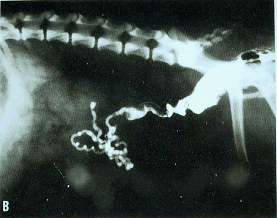
Neoplasia
 239 239
- Neoplasia should be ruled out when looking at
causes of breeding problems
- Transitional Venereal Tumors (TVT)
- Complaint may be
vaginal discharge.
- Vaginal Cytolotogy
-
Prominant nucleoli
-
Mitotic figures
- Transitional bladder carcinomas
- Leiomyomas
Endometrial cyts
-
A 'hot' topic these days
-
Cysts in the endometrium seen as
a process in Cystic Endometrial Hyperplasia (CEH)
-
Are usually seen at surgery (for
AI or as a diagnostic procedure)
-
Can be seen with a great
ultrasound machine (not the portables usually seen in
practice)
-
'Associated' with
infertility.......but
-
Infertile dogs have it
diagnosed at surgery, then ruptured
-
Fertile dogs have not been
examined to note their presence
-
Many practitioners treat them by
rupture, but the verdict is still out on the real success of
this practice.
Estrous Cycle Abnormalities
Failure to Ever Cycle

258

- Always make sure there is no chance that the
bitch had a previous ovariohysterectomy.
-
You can try to palpate
the uterus, look for a ventral midline scar
-
You may test for
persistently high luteinizing hormone (LH) and follicle
stimulating hormone (FSH), which should occur after gonadectomy.
-
The
Status
LH
kits
work
well for
this
-
The
test
had
excellent
sensitivity
(98%)
but
moderate
specificity
(78%)
because
of a
high
frequency
of
false-positive
test
results.
This
means
that
a
single
high
serum
LH
concentration
was
not
a
reliable
indicator
of
ovarian
removal.
However,
a
single
low
serum
LH
concentration
was
an
excellent
indicator
that
a
bitch
was
sexually
intact.
The
LH
test
results
were
positive
within
10
days
after
ovarian
removal
and
remained
high
in
bitches
from
which
ovaries
had
been
removed
> 5
years
previously.
(Evaluation
of a
commercially
available
luteinizing
hormone
test
for
its
ability
to
distinguish
between
ovariectomized
and
sexually
intact
bitches.
Lofstedt,R.M.;
VanLeeuwen,J.A.J
Amer
Vet
Med
Assn
220:2002
pp
1331-1335)
-
Perform vaginal cytology weekly to try to detect estrus.
Delayed puberty
- Delayed puberty is rarely a problem.
- Since dogs can normally take as long as 24 months
to display the first heat, you should wait at least that long
before considering delayed puberty or anestrus.
Chromosomal abnormalities
 259 259
- Several syndromes have been described such as XXY,
XO, XX/XY.
- A karyotype to check the chromosome numbers will
quickly rule these out.
Molecular
Cytogenetics
Laboratory
Room 318 B
Bldg 1197
Department
of
Veterinary
Integrative
Biosciences
Texas A&M
University
College
Station, TX
77843-4458
Telephone:
979-458-0520
Fax:
979-845-9972
Please call
in advance.
Laboratory
led by Dr.
Bhanu
Chowdhary
Also try:
University
of
Pennsylvania
215-573-7545.
Call Ulana
in the
Cytogenetics
lab for
details.
Normal
Chromosome
Numbers
| Species |
# |
Species |
# |
| Cat |
38 |
Domestic pig |
38 |
| Dog |
78 |
Sheep |
54 |
| Donkey |
62 |
Cow |
60 |
| Rabbit |
44 |
Horse |
64 |
| Hare |
46 |
Chicken |
78 |
Sex reversal
 193 193
- Sex reversal is when the genotypic sex disagrees
with the phenotypic sex.
- This is an inherited disease in Cocker Spaniels.
It is an autosomal recessive.
Male pseudohermaphrodites
 193 193
- These are named after the Y chromosome they have,
but they have female genitalia.
- Testicular feminization
Ovarian agenesis
- This is a rare condition which is sometimes seen
in dogs that have not cycled.
- You may need to do a laparotomy to diagnose this
condition.
Endocrine Problems
Cushing's, Addison's, Hypothyroid
 270 270
- These diseases usually do not cause embryonic death (EED)
or infertility, rather the bitches just do not cycle.
- Bitches will usually show the classic clinical
signs associated with the disease.
- Free T4 is best to diagnose hypothyroidism,. The
LSU values are : 10.3-24.5 normal, 5.1-10.2 suspect, <5.1 low.
TSH stimulation can also be used as diagnostic test.
- Most bitches respond well to therapy supplemental
thyroid therapy and start to cycle in 4-6 weeks.
- Hypothyroidism is known to be familial.
- Bitches with Cushing's and Addison's should be
treated appropriately to start the bitch cycling again.
Exogenous Steroid Therapy
Clinical Management
-
Do not attempt to induce estrus before
the cause of the anestrus is ascertained.
-
You can easily perform weekly
vaginal
cytology examinations
to see if the bitch is truly cycling and the owner is just not observing
a heat.
-
Most of our anestrus bitches are 'cured' this way.
Failure to Cycle With
Previous Cycles

- Endocrine problems can be considered here also.
- Failure to observe estrus is a big problem. As
with anestrus bitches, weekly vaginal cytology exams can 'cure'
many of these.
Old Age
 269 269
- As dogs get older they usually have longer
interestrous intervals.
- Dogs must usually be greater than 8 - 10 years
before they will actually stop cycling.
Premature Ovarian Failure
- Premature ovarian failure is similar to the
'menopause' (menopause is not a correct term in dogs because they
have no menses, but everyone will know what I mean), but it occurs
in young bitches.
- Rule out other problems first, before considering
this.
- It may be diagnosed by the high follicle
stimulating hormone (FSH), and luteinizing hormone (LH)
concentrations and there is no gonadal feedback to keep these
hormones at low concentrations.
- In reality, it is hard to find a
lab that will run these tests and that knows what the values
should really be. Maybe BET labs.
Luteal cysts
 198 198
- These are abnormal luteal like structures that
secrete progesterone, but do not undergo luteolysis as a normal
corpus luteum would. This syndrome is common in cows, but may not
be that common in dogs. It was reported in 9/400 dogs by Dow.
Diagnosis
- Progesterone concentrations have not been
reported, but are probably high.
- The prolonged high progesterone must not be
confused with normal cycles.
- Ultrasound may be helpful, but it is not easy to
routinely ultrasound a bitch's ovaries.
- Laparotomy and histology may be needed truly
diagnose the condition.
Treatment
- Prostaglandins are usually not successful. These
structures may lack normal prostaglandin receptors. Whether this
is true or not, I do not know, but it makes a good theory.
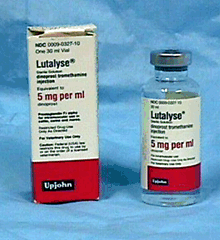
- A single 50 mcg GnRH dose may cause further
luteinization and induce prostaglandin receptors.
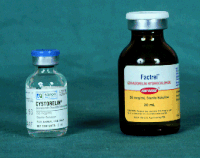
- The structures may have to be removed or drained
via a laparotomy.
Ovariectomy (unilateral in a breeding bitch) may be an
alternative.
Silent heat
- Silent heat may occur as Greyhounds commonly have
a pseudogenetra (overt pseudopregnancy) without ever showing signs
of heat.
Prolonged Estrus

- If estrus is prolonged more than about 10 days,
fertility is usually low. This may be because the oocytes are aged
when they ovulate, the follicles are anovulatory, or the follicles
have become cystic.
Follicular cysts
 195 195
- Many follicular cysts seen on laparotomy are
nonfunctional ovarian cysts and are incidental findings only and
the bitch has shown no problems.
- Estrogen producing cysts cause a prolonged heat (of elevated estrogen concentrations (greater than the normal 50 ng)
- Diagnosis is based on clinical signs, possibly on
estrogen concentrations (although they are hard to run accurately
and interpret), and histology after laparoscopy/laparotomy.
- Split heats in young dogs may confuse the
diagnosis.
- Treatment
- You can give Human Chorionic Gonadotrophin hCG at
a dose of 500 IU SID for 3 days or
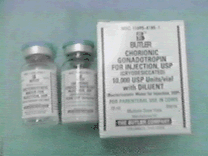
- GnRH - 50 mcg SID 3 days in an effort to
luteinize the cyst and stop the estrous behavior.
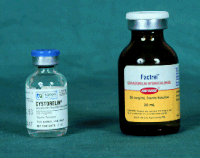
Ovarian Tumors
 200 200
- These are seen more in older nulliparous dogs.
- Granulosa
cell tumors may have no estrogenic
signs, even though they are granulosa cells.
- Cystadenoma
- Fibroma
- Diagnosis of tumors is best done via
laparotomy.
Liver Disease
- Since the liver metabolizes steroids, any liver
disorder may cause problems with the bitch's cycle.
Split Heats
- Split heats are when a bitch shows signs of heat
for a few days (bleeding), then stops for 2-10 weeks, and then a
normal cycle occurs.
- This is a fairly normal event in young bitches
and should always be investigated before looking into other
problems that prolong estrus.
- There is no infertility associated with this
condition.
Short Interestrous (Anestrous)
Intervals

- Since the bitch normally needs a 150
day interestrus (or 90 day anestrus) for endometrial repair
to be complete, bitches that have shorter interestrous intervals are usually
infertile.
- This could also be because of a failure to
ovulate, hence there really was no luteal period. This can be
diagnosed by checking progesterone concentrations.
- Split heats must also be ruled out.
Treatment
- Mibolerone
administration for 6 months is recommended by Feldman and Nelson
and then breed at the next estrus. In our experience, this has resulted in
poor fertility. It also may not be available in the United States at
this time.
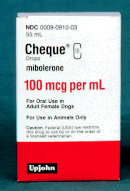
- Megestrol acetate (Ovaban)
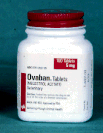
- Although this is a theoretically poorer treatment
(remember it is the progesterone that creates the need for
endometrial repair and Ovaban is a progestatgen) the fertility
results have clinically been better.
- Treatment with 1 mg/lb during the first 3
days of a short interestrus interval delayed heat and resulted
in conception in 10/10 that had been infertile due to short
interestrus intervals.
Ovulation Failure
 270 270
- If the cycle appears normal, yet the bitch is not
pregnant, she may not have ovulated.
- This can be definitively diagnosed by the bitch
having low progesterone 30-45 days after the first day of diestrus.
- However, the bitch may fail to ovulate, yet the
follicles luteinize, therefore resulting in high progesterone, yet
not ovulation.
Hypoluteoidism
 269 269

-
Luteal insufficiency (lack of progesterone secretion by
the corpora lutea) has been speculated to occur in the bitch and has
recently been documented.
-
Ovariectomy at any stage of pregnancy
induces abortion within 48 hours.
-
Luteal insufficiency is suspected when a bitch has a
history of being pregnant and then fails to whelp; however, at least
four ruleouts for pregnancy loss should be investigated before luteal
insufficiency can be seriously considered.
-
First, an accurate pregnancy
diagnosis must be assured. Ultrasound diagnosis of pregnancy gives both
the clinician and the client an absolute assurance that the bitch is
truly pregnant. If the bitch was pregnant and failed to whelp,
identifying the gestational stage of the pregnancy loss will help
determine subsequent treatments. Unless serial pregnancy determinations
are performed, however, the clinician will rarely have this information
on the bitch's first presentation.
-
Brucella
canis must also be considered a rule out in
any pregnancy loss.
-
Endometritis and cystic endometrial hyperplasia may
also be suspected in cases of pregnancy loss.
-
Finally, lethal congenital
defects must be ruled out using test matings to another stud and/or
necropsy of an aborted fetus.
-
If all of these
conditions are ruled out, then luteal insufficiency can be seriously
considered.
-
If a bitch is suspected of having luteal insufficiency,
serial progesterone determinations can be performed starting
approximately one week before the anticipated abortion.
-
Since the bitch
must maintain at least 2 ng/ml of progesterone in order to maintain
pregnancy and since a decline below this value for greater than 24 hours
will result in abortion, the timing of progesterone concentrations is
important.
-
If the time frame of the pregnancy loss is unknown, then
progesterone concentrations should be determined immediately after the
pregnancy is diagnosed.
-
Radioimmunoassay determinations of progesterone
are of little use when immediate progesterone values are needed.
-
If rapid quantitative
progesterone values are available, they are the most accurate.
-
An alternative progesterone test is the ELISA, which can be performed in a
matter of minutes.
-
The ELISA test has three possible results for the
progesterone concentration, <1 ng/ml, 2-7 ng/ml, and > 7.5 ng/ml.
-
If the initial ELISA sample shows the progesterone > 7.5 ng/ml, it
may need to be analyzed by radioimmunoassay to determine the exact
concentration.
-
The frequency of the progesterone analysis should be
based on the progesterone concentration.
-
If the concentration is high
(20-50 ng/ml) then the samples only need to be taken weekly; however, if
the concentration is low (5-10 ng/ml) then the samples should be taken
daily.
-
If the progesterone is in the 2 ng/ml range, a diagnosis of
luteal insufficiency definitely can be made.
-
It may be safer to use 5 ng/ml
as a diagnostic cutoff point for luteal insufficiency so that no bitches
with borderline progesterone concentrations are left untreated.
-
Total progesterone concentrations can be monitored
while the bitch is being supplemented with exogenous progesterone to
determine if supplementation is providing a concentration of at least 5
ng/ml.
-
Endogenous progesterone can be monitored only if the bitch is
supplemented with a progestogen that does not cross-react with the
progesterone assay.
-
Once a definitive diagnosis of luteal insufficiency has
been made, treatment can begin.
-
Pregnancy has been successfully
maintained in bitches ovariectomized after 30 days of gestation with
daily IM injections of 20-50 mg/dog (about 2-3 mg/kg) of progesterone in
oil.
-
Daily IM injections of 3 mg/kg progesterone in
sesame oil will maintain a progesterone concentration greater than 10 ng/ml
in anestrus bitches.
-
Since at least 2 to 5 ng/ml of progesterone are
needed to maintain pregnancy, 3 mg/kg administered IM daily should
provide enough exogenous progesterone to maintain pregnancy.
-
In one
report, however, a bitch diagnosed as having luteal insufficiency
maintained pregnancy successfully after administration of 2 mg/kg of
progesterone in oil IM every 48 hours along with monitoring plasma
progesterone concentrations.
-
This bitch, unlike the
anestrus bitches in another study, did have some
endogenous progesterone secretion; so it probably did not need the
frequency of administration to keep the plasma concentration of
progesterone above 5-6 ng/ml.
-
Because injectable progesterone is
difficult for an owner to administer, and because endogenous
progesterone secretion cannot be monitored when natural progesterones
are administered, an oral progestogen is an ideal alternative.
-
An oral
progestogen, ally-trenbolone, has been approved to maintain pregnancy in
the mare.
-
A dose of 0.088mg/kg ally-trenbolone (0.2cc/10 lbs) maintained
pregnancy in 3/3 bitches ovariectomized in midgestation and 1/3
ovariectomized early in gestation.
-
In contrast, the single control bitch
(not supplemented) lost the pregnancy within 48 hours after ovariectomy.
-
One bitch whelped on the expected due date but lost all the puppies
because of fetal dystocia.
-
The other two bitches whelped normal litters
on the expected due date.
-
The milk production was not optimal initially
in these bitches, but after 2-3 days it was adequate to raise most of
one litter and all of the other litter.
-
Because the prolactin
concentration rises dramatically before parturition (Concannon, 90), the
lactation inhibition may be related to an ally-trenbolone mediated
prolactin suppression near term.
-
A client should be advised that milk
supplementation of the puppies may be needed if the bitch is
supplemented with ally-trenbolone.
-
It is also imperative to calculate
the whelping date accurately.
-
The administration of exogenous
progesterone for two days beyond the anticipated whelping date increases
the chance of stillborn puppies.
-
Similarly, if the
progesterone is discontinued too early, immature and/or stillborn
puppies may result.
-
Gestation length is consistent if measured from the
LH surge or the first day of cytologic diestrus.
-
If only breeding dates
(or worse yet AI dates) are known, the accuracy of the estimated
whelping date is compromised.
-
There may be a masculinization of female
puppies after ally-trenbolone treatment. Experimentally it was not seen,
but several cases have been reported by practitioners using the
protocol. Administration of excess progesterone during gestation will
also masculinize female pups, so the masculinization seen by
practitioners may have been dose related (they supplemented bitches with
already high progesterone).
-
If a careful diagnosis of luteal insufficiency is made,
pregnancy can be maintained successfully using either oral or injectable
progestogens. The client must be advised about the problems of
estimating gestation length, poor milk production, and potential
masculinization of female puppies that may make the treatment
undesirable.
Miscellaneous Causes of
Infertility
 270 270
- Male origin
- Sperm antibodies have been produced
experimentally., but have not been isolated as yet clinically.
- Sperm inhibitors in mucus - same as sperm
antibodies
- Inbreeding - Vicki Myers-Wollen at Cornell found
that as the inbreeding coefficient rises in a kennel, fertility
decreases, fecundity decreases and neonatal deaths increase.
|
 Next
Page
Next
Page Canine
Index
Canine
Index

